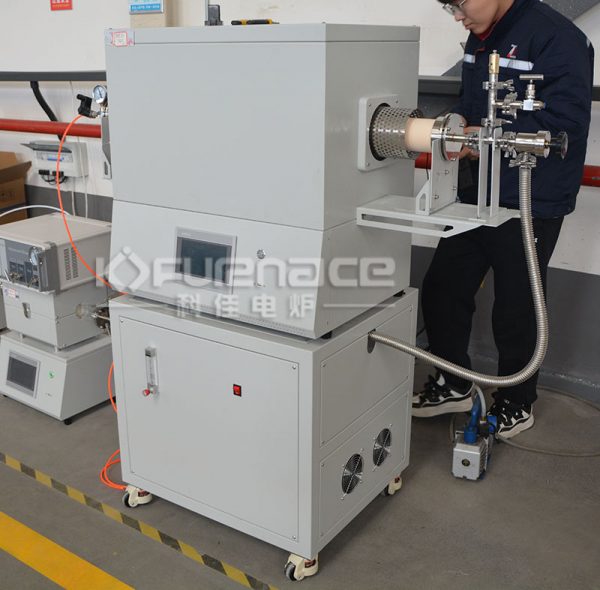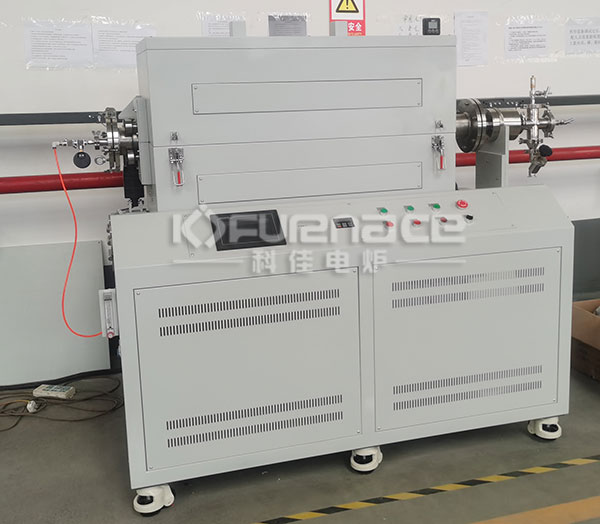High temperature gas vacuum tube furnace is a precision equipment that achieves high-temperature processing in a vacuum or controlled atmosphere environment. It has a wide range of application scenarios and is highly favored by university teachers, students, research institutes, and enterprises. Let’s take a detailed look at the high temperature gas vacuum tube furnace below!

1600 ℃ Atmosphere Tube Furnace (Click on the picture to view product details)
1. Core functions
Vacuum environment simulation
By using a vacuum pump to reduce the pressure inside the furnace to a very low level (usually 10 ⁻ ² Pa to 10 ⁻ ³ Pa), oxygen, water vapor, and other gas molecules in the air are removed to prevent oxidation, decarburization, or decomposition reactions of materials at high temperatures. For example, in metal smelting, a vacuum environment can prevent metal oxidation and improve purity; In semiconductor manufacturing, it can prevent the formation of oxide layers on the surface of silicon wafers.
Controllable atmosphere treatment
Support the introduction of protective gases such as nitrogen, hydrogen, argon, or mixed gases (such as H ₂/N ₂) to achieve specific chemical reaction conditions. For example, in the growth of carbon nanotubes, acetylene is introduced as a carbon source and hydrogen is used as a catalyst carrier to catalyze the formation of carbon nanotubes at high temperatures.
High temperature precise control
The working temperature range is wide, reaching over 200 ℃ to 1800 ℃. Through intelligent temperature control systems such as PID regulation and multi-stage program temperature control, the temperature control accuracy of ± 1 ℃ is achieved, meeting the requirements of fine processes such as material phase transition and grain growth.
2. Technical characteristics
Structure and Materials
Furnace body design: Adopting a double-layer shell structure, integrating air or water cooling systems, with low surface temperature and safe operation. The furnace is usually made of high-purity alumina fiber or ceramic fiber, which has good insulation performance and is not easily deformed.
Furnace tube material: optional corundum tube (high temperature resistance, high mechanical strength), quartz tube (good transparency, suitable for observing reactions) or heat-resistant steel tube (suitable for corrosive atmospheres).
Heating element: using silicon carbon rod, silicon molybdenum rod or resistance wire, heating the material inside the furnace tube through thermal radiation, with fast heating rate and high efficiency.
control system
Intelligent temperature control: equipped with thermocouple sensors and intelligent temperature controllers, real-time monitoring and adjustment of furnace temperature, supporting multi-stage program temperature control (such as 30 stage heating program).
Atmosphere management: precise control of gas flow rate through quality flow meters, combined with anti backflow devices and exhaust gas collection systems, to ensure experimental safety.
Vacuum system: composed of a vacuum pump, vacuum gauge, and sealing device, it can quickly evacuate to the set pressure and maintain stability.
Safety and Convenience
Safety protection: Integrated overcurrent and over temperature protection devices, automatically power off when the temperature or current exceeds the set value to prevent equipment damage.
Operation interface: equipped with touch screen or remote control system, supporting experimental parameter preset, real-time monitoring and data export, easy to operate.
Modular design: The furnace can be opened for easy cleaning and maintenance; Optional accessories such as observation windows and sample holders can be provided to meet different experimental needs.
3. Application Fields
Materials Science Research
Ceramic sintering: High temperature sintering of ceramics such as silicon nitride and aluminum oxide in nitrogen gas to improve hardness and wear resistance.
Nanomaterial synthesis: Growth of nanostructures such as carbon nanotubes and graphene on substrates through chemical vapor deposition (CVD).
Semiconductor thin film growth: Epitaxial growth of gallium arsenide, gallium nitride and other semiconductor thin films on a single crystal silicon substrate for the manufacture of high electron mobility transistors (HEMTs).
metal heat treatment
Annealing and quenching: eliminating internal stress in metals in argon gas to improve processing performance; Alternatively, quenching can be achieved through rapid cooling to increase hardness.
Carburizing and nitriding: methane or carbon monoxide is introduced to form a carbide or nitride layer on the metal surface, improving wear resistance and corrosion resistance.
Preparation of composite materials
In situ reaction: promotes chemical reactions between the matrix and the reinforcement at high temperatures (such as the reaction of Si and C to form SiC), forming strong interfacial bonding.
Hot pressing: Combining high temperature and pressure to promote material densification, reduce porosity, and improve mechanical properties.
Catalyst preparation
Carrier pretreatment: High temperature calcination of alumina carrier to remove surface impurities and adjust pore structure.
Active component loading: Metal salt solution is loaded onto a carrier by impregnation method, and after high-temperature reduction, a highly dispersed catalyst (such as automobile exhaust catalyst) is formed.
new energy sector
Lithium ion battery materials: calcining rich lithium manganese based cathode materials in oxygen to enhance capacity.
Solar cells: Prepare silicon-based thin-film solar cells in nitrogen to improve photoelectric conversion efficiency.

Atmosphere Rotating Tube Furnace (Click on the picture to view product details)
4. Operation points and precautions
Pre drying treatment
After the first use or long-term idle, it is necessary to bake at 120 ℃ for 1 hour and 300 ℃ for 2 hours to remove moisture from the furnace and prevent cracking.
Heating rate control
Corundum tube: heating rate ≤ 5 ℃/min; Quartz tube: heating rate ≤ 10 ℃/min, cooling rate ≤ 15 ℃/min, to avoid thermal stress causing furnace tube rupture.
Atmosphere management
Before ventilation, it is necessary to check the sealing of the air circuit to prevent air leakage; When using flammable gases such as hydrogen, a detonation test must be conducted to ensure safety.
After the experiment, turn off the heating power first and wait for the furnace temperature to drop below 100 ℃ before closing the gas valve to prevent backflow.
Sample placement
The sample should be placed in the middle of the furnace tube and sealed at both ends with insulation plugs to reduce heat radiation loss and improve temperature uniformity.
Maintenance and Care
Regularly check whether the connection points of the heating element are tightened to prevent local overheating caused by poor contact.
When replacing vacuum system seals (such as silicone rings), it is necessary to ensure that they are installed in place and maintain the vacuum level.Click to learn more tube furnaces! Or click on online customer service to learn more about product information!